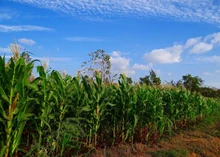
Along the Indian coastline, cyclones are becoming more frequent and intense. In the last couple of years, Cyclones Nisarga, Tauktae, and Amphan have caused widespread devastation to several Indian cities. Let’s see the reason behind the growing intensity and frequency of cyclones in India.
What are cyclones? And how are they formed?
Merriam-Webster dictionary defines a cyclone as, “a storm or system of winds that rotates about a center of low atmospheric pressure, advances at a speed of 30 to 50 kilometers an hour, and often brings heavy rain.” In simple terms, a cyclone is a system of strong winds that are rotating inwards around a low-pressure center. When the winds in the rotating storm reach 63 km/hr, then the storm is categorized as a “tropical storm.”
Cyclones are formed because the warm and moist air over the ocean rises due to less density. This leaves less air near the surface of the water and ends up creating a low-pressure zone. The air flows from high-pressure areas over the low-pressure zone, quickly warms up, and forms a cycle. This cycle leads to the formation of clouds.
The cloud and wind system starts to spin and grow because of the constant heating and evaporating process. As this process accelerates, the eye of the cyclone or the zone which is calm and clear because of low air pressure starts forming in the center. And that is how a cyclone is formed.
Causes of cyclone
Cyclones are caused by-
Warm sea surface temperature
Atmospheric instability
Increased humidity in the lower levels of the troposphere
Pre-existing low-level disturbance or focus.
Why are cyclones occurring frequently in India?
India’s long coastline which is approximately 8041 km, is exposed to 10 % of the world’s tropical cyclones. The west and the east coast of India experience cyclonic storms often. The Indian Meteorological department of India says that at least 13 coastal regions and Union Territories in India are prone to cyclones. Some of these states are West Bengal, Tamil Nadu, Gujrat, Odisha, and Andhra Pradesh.
According to climate experts, unplanned urban development and the destruction of our ecosystem have contributed to the increase in both the frequency and intensity of cyclones. Climate change is rapidly warming the Indian Ocean and it is also increasing the damage that cyclone causes. For instance, the increasing sea surface temperature is not only making the cyclones more intense but is also increasing the intensity of rainfall during the cyclone as well as the distance inland that the storm surges can reach.
According to a review paper published by scientists Vineet Kumar Singh and Roxy Matthew Koll from IITM-Pune in the journal Earth-Science Reviews, the global ocean has absorbed at least 90% of the excess heat generated. This has led to massive ocean warming and stronger intensities of the storm, particularly in the Northern Indian Ocean. According to this review, there has been a 52% increase in the number of cyclones in the Arabian Sea because the surface temperature has increased by 1.2-1.4°C.
The vulnerability of cities along the coastline of India has also increased because of unplanned development. Studies show that cities such as Mumbai and Kolkata face severe threats from climate-induced flooding because these cities fail to address the risks of development in ecologically sensitive zones. These studies also indicate that the methodical deforestation of mangrove forests, which act as a buffer zone against storm surges and floods, is also a major reason behind the increase in intensity.
The impact of frequent cyclones on Indian cities is damaging for many reasons. Torrential rainfall along with high wind speed causes large-scale damage to buildings, houses, and other infrastructure. Cyclones contribute to the rising seawater levels which erode beaches and embankments and also expose the coastal areas to flooding. In addition to this, cyclones also result in damage to vegetation and livestock.
Cyclone Categories
Natural Disaster Management of India has categorized cyclones into 5 categories depending upon the strength of the winds produced, the potential damage to infrastructure, and flooding upon landfall.
Category 1- Category 1 cyclone causes minimum damage to the roads and infrastructure caused by landfall. The storm surge is 4 to 5 feet and the wind speed ranges between 74-95 m/hr.
Category 2- The wind speed of a Category 2 ranges between 96 to 110 m/hr. The storm surge is between 6 to 8 feet and moderate damage is caused to the infrastructure because of landfall.
Category 3- The storm surges between 9 to 12 feet in a Category 3 cyclone. The wind speed ranges between 111 to 130 m/hr, and extensive damage is caused to the infrastructure due to landfall.
Category 4- The damage caused by landfall produced by a category 4 cyclone is extreme. The wind speed of a Category 4 cyclone is between 131 to 155 m/hr and the storm surges between 13 to 18 feet. For instance, Cyclone Tauktae, which made landfall in Gujrat, had a windspeed of 140 m/hr and caused power outages in the impacted area. It even caused several maritime incidents and caused damages worth 2.1 billion US dollars.
Category 5- A Category 5 cyclone is considered catastrophic due to the damage it causes by landfall. The storm surges above 19+ feet and the windspeed exceeds 155 m/hr. For example, the 1999 Odisha Cyclone is the most intense cyclone recorded to this date. The maximum wind speed during this cyclone was 160 m/hr.
Four stages of Cyclone Warning
The Indian Meteorological Department issues 4 stages of warnings for cyclones along the Indian coast. These are-
Stage 1- Cyclone watch is the first stage of a cyclone warning and is issued 72 hours in advance. This warning indicates that there is a high likelihood of cyclonic disturbance in the Indian Ocean and that the coastal region of India may experience adverse weather.
Stage 2- Coastal areas are issued a cyclone alert 48 hours in advance of adverse weather.
Stage 3- A cyclone warning is the third stage and is issued 24 hours in advance of adverse weather in coastal areas. During this stage, the locations where there is a likelihood of landfall are discussed.
Stage 4- 12 hours before the commencement of adverse weather in the coastal area the landfall outlook warning is issued. In stage 4, information about the cyclone's direction and the possible impact of landfall is discussed.











